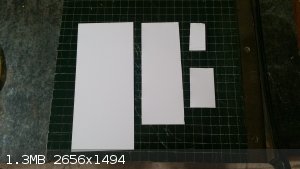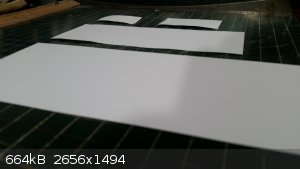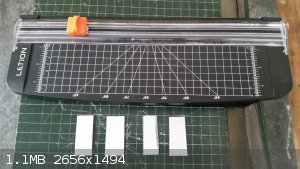
soma - 5-4-2018 at 01:55
Wondering if there is a scissor made for cutting plastic and aluminum tlc plates that can make good right angles on the cut so that the sides are at
90 degrees to the bottom?
Thanks.
DrP - 5-4-2018 at 05:32
Isn't it usually done with a ruler and a scalpel? Or was that just when we were at school?
AvBaeyer - 5-4-2018 at 18:22
A scissor can cause bad edges which affect how the plate will run. You should use a ruler and a sharp blade like a scalpel, razor blade or exacto
knife.
AvB
Review of TLC Plate Cutting Tools
Jenks - 31-5-2020 at 05:42
I have some plastic plates I have been cutting with scissors but wanted to try aluminum plates to be able to heat with stains, or to be able to char
the spots onto the plate for visualization. I remember aluminum plates cutting poorly with scissors, and so invested in a couple paper cutters to see
which way would work best.

The above picture shows aluminum-backed TLC plates, sitting on an old-fashioned Milton Bradley guillotine paper cutter. The plate in the upper right
was cut with scissors. The corners aren't square, cuts aren't straight, some silica was broken off and it is bent. The top edge of the bottom-right
plate, and the right edge of the middle plate, were also cut with scissors. It helped to try more than one pair of scissors to find the one that cut
most cleanly.
The left edge of the bottom-right plate, left edge of the middle plate and right edge of the left plate were cut using the shown paper cutter. Using
the grid on the paper cutter as a guide, this gives square corners. Cuts are also straight. The piece cut off, to the right of the blade, seems to get
slightly bent, and also loses about a quarter millimeter of silica along the edge. The piece that remains on the cutter stays flat and gets a clean
edge. Since the strip of missing silica forms a straight line, I wouldn't expect this to interfere with chromatography as much as the irregular loss
of silica caused by scissors.

The above picture shows the bend in the TLCs introduced by both scissors and paper cutters.

The third cutter tested was this newly purchased one containing a razor blade shown in the picture above. This one wasn't able to cut the
aluminum-backed plates. The plastic-backed TLC on the left cut reasonably well with scissors, as did the second from the left cut by the guillotine
paper cutter. Both of these plates lost a little silica in a straight line along the edge.
The two plates on the right were cut on the razor paper cutter shown. The orange razor holder made a wide scrape in the silica, destroying the plate,
as seen on the second right. Cutting the plate with the silica side down still destroyed the plate, as seen on the right.
So my advice is, if you only do TLC occasionally or only have plastic-backed plates, try out several pairs of scissors until you get satisfactory
cuts, and mark the plates with pencil to help get straight cuts and square corners. If you plan to use aluminum-backed plates regularly, invest in a
guillotine paper cutter. I obtained mine for about $40 off ebay.
[Edited on 31-5-2020 by Jenks]
oblivionbubble - 2-6-2020 at 06:14
We usually used a craft knife and a ruler. I guess scalpel would work as well.
Mush - 18-9-2021 at 02:10
Top tips.
https://www.chemicalforums.com/index.php?topic=62368.0
https://www.erowid.org/archive/rhodium/chemistry/equipment/t...
